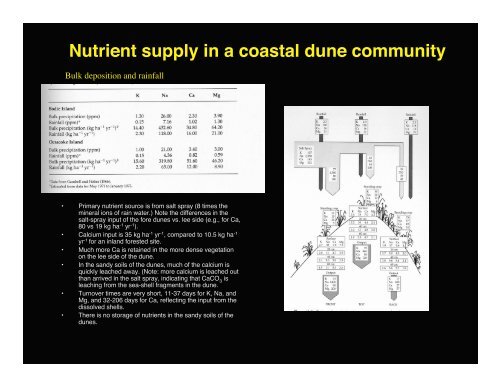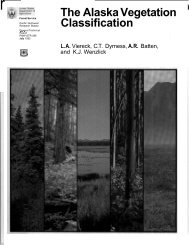Lesson 32 Mineral Cycling - Alaska Geobotany Center
Lesson 32 Mineral Cycling - Alaska Geobotany Center
Lesson 32 Mineral Cycling - Alaska Geobotany Center
You also want an ePaper? Increase the reach of your titles
YUMPU automatically turns print PDFs into web optimized ePapers that Google loves.
Nutrient supply in a coastal dune community<br />
Bulk deposition and rainfall<br />
• Primary nutrient source is from salt spray (8 times the<br />
mineral ions of rain water.) Note the differences in the<br />
salt-spray input of the fore dunes vs. lee side (e.g., for Ca,<br />
80 vs 19 kg ha -1 yr -1 ).<br />
• Calcium input is 35 kg ha -1 yr -1 , compared to 10.5 kg ha -1<br />
yr -1 for an inland forested site.<br />
• Much more Ca is retained in the more dense vegetation<br />
on the lee side of the dune.<br />
• In the sandy soils of the dunes, much of the calcium is<br />
quickly leached away. (Note: more calcium is leached out<br />
than arrived in the salt spray, indicating that CaCO 3<br />
is<br />
leaching from the sea-shell fragments in the dune.<br />
• Turnover times are very short, 11-37 days for K, Na, and<br />
Mg, and <strong>32</strong>-206 days for Ca, reflecting the input from the<br />
dissolved shells.<br />
• There is no storage of nutrients in the sandy soils of the<br />
dunes.
















